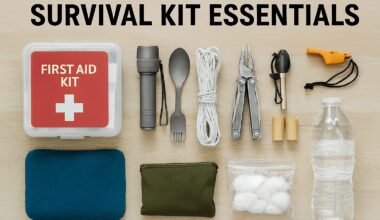Survival depends on your knowledge as much as the equipment you brought when you’re in the middle of nowhere or an emergency. What if the things in your glove box or on the shelves in your kitchen might come to your aid? They certainly can if they have a little ingenuity and expertise.
This guide dives into survival hacks using common household items, transforming the ordinary into the extraordinary. These tactics give hikers, outdoor enthusiasts, and environmental lovers clever, useful solutions to get over unforeseen obstacles.
These suggestions demonstrate that ingenuity is the most effective survival gear available, whether you’re looking for clean water, creating a shelter, or staying warm. Continue reading to learn how common household items might turn into effective partners in the outdoors.
1. Duct Tape for More Than Repairs
Duct tape is a survivalist’s best friend. Strong, waterproof, and endlessly versatile, it’s one of the most valuable survival hacks using common household items. Use it to bind bandages, repair holes in tents or equipment, or even build a homemade rope or cup.
If your shoes fall apart, you can wrap them around your feet or twist them into cords to tie branches together. When first aid supplies are limited, duct tape can also be used to seal wounds or stabilize a damaged ankle.
It is weatherproof, lightweight, and easy to pack. A little ingenuity goes a long way when it comes to duct tape. You never know when a roll’s versatility could help you get out of a tight jam, so always keep one in your backpack.
2. Tampons as Filters and Kindling
While they might seem out of place in a survival kit, tampons are powerful multi-use tools, one of the more surprising survival hacks using common household items. When fluffed up, they make great fire starters since they are made of sterile cotton that is packed firmly.
Their absorbent fibers can also be used to filter particles from contaminated water before boiling in an emergency. Some survivalists even use them as makeshift bandages or to stop nosebleeds.
Tampons are a surprisingly useful tool when you’re short on supplies because they’re small and come in waterproof packaging. Their versatility serves as a reminder that sometimes the best survival equipment is right in front of you.
3. Aluminum Foil as a Cooking and Signal Tool
Aluminum foil isn’t just for the kitchen; it’s one of the most versatile survival hacks using common household items. Boil water with it, prepare food over an open fire, or reflect heat toward your shelter.
It can even serve as a temporary frying pan or a stovetop windbreak. Beyond cooking, foil is a great signaling tool because it reflects sunlight brilliantly and can attract rescuers’ notice.
It folds up simply and fits into any pack because it is lightweight. You’re preparing for anything when you have aluminum foil in your bag, not just meals.
Get to read more on how aluminum foil serves as an emergency cooking hack when camping
4. Hand Sanitizer as Fire Starter
In the outdoors, hand sanitizer is a dependable fire starter in addition to being a necessary hygiene item. It is combustible and easily ignited, especially in cold or damp conditions, due to its high alcohol content.
Among the most effective survival hacks using common household items, this one is invaluable for outdoor adventurers who need a dependable ignition source. Apply a tiny bit to dry tinder, such as tissue paper, wood shavings, or cotton balls, to use it.
A spark from a battery arrangement or flint and steel will readily catch. In less-than-ideal conditions, the slow burn is perfect since it allows you ample time to light larger kindling or slightly damp fuel.
Nevertheless, when water is scarce, hand sanitizer also helps prevent infection by keeping hands bacteria-free and disinfecting small incisions. A tiny travel-sized container can be used as a disinfectant, fire starter, and even an emergency wound cleaner, and it weighs very little in your pack.
This multifunctional tool is an example of clever packing for hikers and nature lovers. Hand sanitizer is an invaluable ally in any circumstance where fire is a major concern and resources are scarce. It is a necessity for your camping kit and is both small and useful.
5. Crayons as Emergency Candles
When the sun goes down and darkness begins to set in, light becomes essential for survival. Crayons, yes, the coloring sort, are useful in this situation. They may seem like children’s art supplies, but they’re clever survival hacks using common household items.
Made of wax with a paper wrapper, each crayon can burn like a mini-candle for up to 30 minutes. Light the paper with a match, lighter, or spark to begin using the crayon. The melting wax keeps the flame going after the wrapper catches.
It’s enough to light your tent, build a fire, or light your path in low light, but not bright enough to flood an area. That little flame can have a huge impact in an emergency.
Crayons are small, light, and convenient to take in a first aid kit or a plastic bag. Additionally, unlike lantern oil or conventional candles, they won’t spill or leak.
They provide a lightweight backup light source for long-distance hikers, survivalists, and minimalist campers. Add some crayons to your bag the next time you’re packing. Even though they don’t appear to be survival gear, they will demonstrate your resourcefulness when the lights go out.
6. Garbage Bags as Shelter and Rain Gear
A heavy-duty plastic garbage bag might be the most underappreciated item in any survival kit. Durable, lightweight, and completely waterproof, it’s one of the most effective survival hacks using common household items, especially when dealing with rain, cold, or the need for emergency shelter.
A waste bag can be transformed into a ground tarp, a sleeping bag shell, a poncho, or even a rainwater collector with a little ingenuity. Use one as a windbreaker around your fire, rope it between trees, or cut one open to form a temporary shelter.
It provides additional insulation when stuffed with garments or leaves. In a pinch, it offers significant protection, but when folded up, it hardly takes up any room in your bag.
This multifunctional utility keeps you warm, dry, and protected whether you’re in muddy terrain or are confronted with an unexpected rainstorm.
It’s an obvious addition to your basics for lengthy hikes and outdoor excursions.
Garbage bags show that survival isn’t about having fancy gear; it’s about making smart choices. Keep a few in your pack and stay prepared for anything nature throws your way.
7. Baking Soda for First Aid and Hygiene
Baking soda is a humble yet powerful ingredient in the world of survival. Tucked into a zip lock bag or small tin, it offers an array of health, hygiene, and comfort benefits, making it a top contender among survival hacks using common household items.
Its inherent antibacterial and anti-inflammatory qualities make it ideal for soothing insect bites and cleansing minor wounds. You can use it as a toothbrush, deodorant, or to freshen your water bottle and equipment in the wild, where maintaining cleanliness is more challenging.
Sunburn or mild skin irritations can also be treated using a paste mixed with baking soda and a little water. Along with being helpful in first aid, baking soda can be used as a last resort to clean cookware over a campfire, fragrance clothing, and absorb moisture in shoes.
It is a valuable piece of equipment for any hiker or camper because of its many uses, lightweight design, and extended shelf life.
Using commonplace objects in unique ways is the very core of smart survival, and this one element embodies it. For people who appreciate safe, efficient solutions without carrying extra, baking soda adds dependability and comfort to any outdoor situation.
Conclusion
Mastering survival doesn’t mean carrying more gear; it means thinking more creatively. These survival hacks using common household items prove that preparation starts at home.
Commonplace items that you might not think of, like crayons lighting the road, duct tape sealing a shelter, or aluminum foil reflecting sunlight, can become the heroes of your next trip.
Examine your house before your next hike or outdoor excursion; you may already have everything you need. Continue to be inquisitive, be ready, and impart these tips to other adventurers who appreciate astute survival.
Are you prepared to transform everyday objects into tools for survival? Now is the moment to confidently explore, so gather your belongings and think creatively. Share this guide with fellow adventurers and inspire resourcefulness in the wild.


